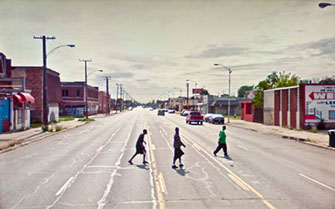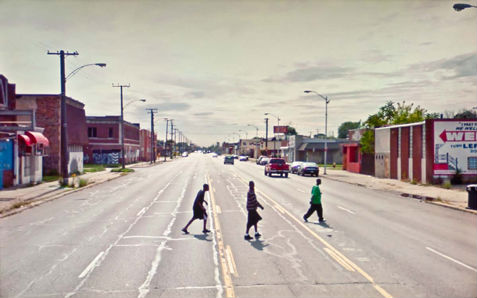"I SORT OF LOST WHO I WAS, AS A PUERTO RICAN, BECAUSE I ASSOCIATED THAT WITH BEING POOR AND BEING OF THE LOWER-MIDDLE CLASS. SO I LOST PART OF MY IDENTITY WHEN I WAS IN COLLEGE, BECAUSE I DIDN'T WANT TO ASSOCIATE WITH THAT; I WANTED TO BE LIKE EVERYBODY ELSE."
Classless Society Stories Project
back to top
back to top
Where I grew up, everybody pretty much was the same class; everybody was hard-working, working middle class, working upper-middle class, lower-middle class, what have you. Everybody got along - different races, different colors, different creeds, different religions. And we just grew up. You know, we hung out together, we played sports together.
Classless Society Stories Project
We like diversity and we like programs such as affirmative action because they tell us that racism is the problem we need to solve and that solving it requires us just to give up our prejudices. (Solving the problem of economic inequality might require something more; it might require us to give up our money.)
Walter Benn Michaels, The Trouble with Diversity: How We Learned to Love Identity and Ignore Inequality (New York: Henry Holt, 2006), 89.
My idea of class has come from my experiences growing up in a working class community of color
in Cambridge, Massachusetts, and then coming to Skidmore College, where it's largely white and elite, in terms of class status. And I think my experiences have showed me that we really need to have concrete analysis of sort of how inequality and power sort of manifests itself. I think that there's a lot of theories and a lot of sort of jargon that goes on in the academy, about what class is. And I think that comes from the fact that the academy itself is a place where mostly bourgeois upper class and middle class people reside. And there's sort of a fear to identify the fact that there are multiple layers and it's about ownership and power, and not really about what kind of income we are making, right?
Classless Society Stories Project
WHERE I GREW UP, EVERYBODY PRETTY MUCH WAS THE SAME CLASS...
CLICK TO READ
WE LIKE DIVERSITY AND WE LIKE PROGRAMS SUCH AS AFFIRMATIVE ACTION BECAUSE THEY TELL US THAT RACISM IS THE PROBLEM WE NEED TO SOLVE AND THAT SOLVING IT REQUIRES US JUST TO GIVE UP OUR PREJUDICES...
CLICK TO READ
MY IDEA OF CLASS
HAS COME FROM MY EXPERIENCE GROWING UP IN A WORKING-CLASS COMMUNITY OF COLOR...
CLICK TO READ
I'M SOMEBODY WHO TRULY BELIEVES IN THE WORDS OF MALCOLM X...
(1:16 min)
CLICK TO PLAY AUDIO
I THINK THAT ME AND MY FAMILY ARE PART OF THE AMERICAN DREAM...
(:58 sec)
CLICK TO PLAY AUDIO
back to top
-
LABOR MARKET DISCRIMINATION
The persistence of a disproportionately high number of racial and ethnic minorities within low-income groups suggests systemic forces at work. One widely accepted argument is that social and economic disparities among blacks, Hispanics, Asians, and whites result from rampant discrimination in the labor market, housing, education, and even public policy.
Discrimination in the labor market - specifically, unfair treatment in the workplace - shows itself in earnings differences among racial and ethnic groups even with similar credentials. According to the latest U. S. Census Bureau data (first quarter, 2013), median weekly earnings for black men holding full-time jobs were $666, 75 percent of the median for white men ($888). The difference shrank among women, with black women's median weekly earnings ($597) 82.6 percent of those for white women ($723). Overall, median weekly earnings of Hispanics who worked full time ($575) were lower than those of blacks ($622), whites ($802), and Asians ($951).
The earnings data, however, do not reflect the complete picture of workplace discrimination. Minority workers are often less likely to be hired in economic upswings and more likely to be laid off in downturns, raising the likelihood of their unemployment. The current unemployment rate of 7.5 percent includes an unequal distribution among the different groups: 6.7 percent for whites, 13.2 percent for blacks, 9 percent for Hispanics, and, for Asians, 5 percent, one-third lower than the national average.
-
INEQUALITY AND OPPORTUNITY
Pay and unemployment differences also result from discrimination that limits occupational choices. For instance, U. S. Bureau of Labor Statistics data show that blacks and Hispanics more often held low-paying jobs than whites and Asians, tending to work in such occupations as construction, maintenance, and material-moving. Whites and Asians more often fill higher-paying management, professional, sales, and office occupations.
Labor market discrimination, however, is not the only source of earnings disparities, which also reflect long-range cumulative effects of discrimination and segregation in housing and education that limit the accumulation of human capital. With educational attainment the key to higher skill and productivity, and hence to higher earning, lack of equal opportunity in primary, secondary, and higher education condemns some groups to low-skill and low-paying work. This "lack of equal opportunity" results from unequal access for some groups to expensive, higher-quality educational institutions. Recent reports in the media argue that students from high-income backgrounds are more likely to receive a high-quality education than students from low-income backgrounds, especially blacks and Hispanics.
-
HOUSING SEGREGATION
Lower-income groups' educational experience also reflects segregation practices in housing. Housing segregation by income and race has increased in the last two decades. A 2012 study by the Pew Research Center finds low-income housing concentrated more and more in lower-income census tracts, and high-income housing concentrated in higher-income census tracts. The majority of blacks and Hispanics live in approximately 45 percent black and Hispanic census tracts. Such racial and ethnic clustering not only limits exposure to others in general but also affects human capital formation. Low-income neighborhoods tend to have low-quality schools, affecting in turn the socioeconomic mobility of the young, perpetuating economic and racial segregation.
Surprisingly, the U. S. government has perpetuated housing segregation and discrimination through policies that concentrate low-income housing projects in impoverished areas and cut affordable housing projects to reduce budget deficits. State and local government programs reinforce existing housing segregation and its effects on racial and ethnic minority groups.


